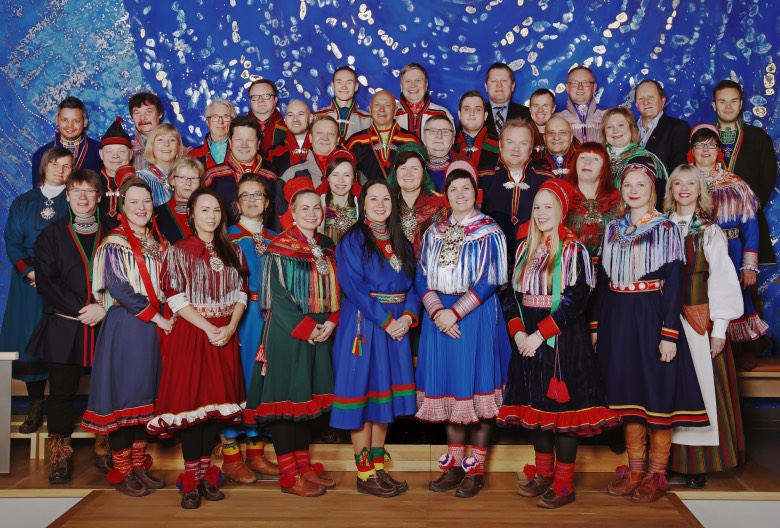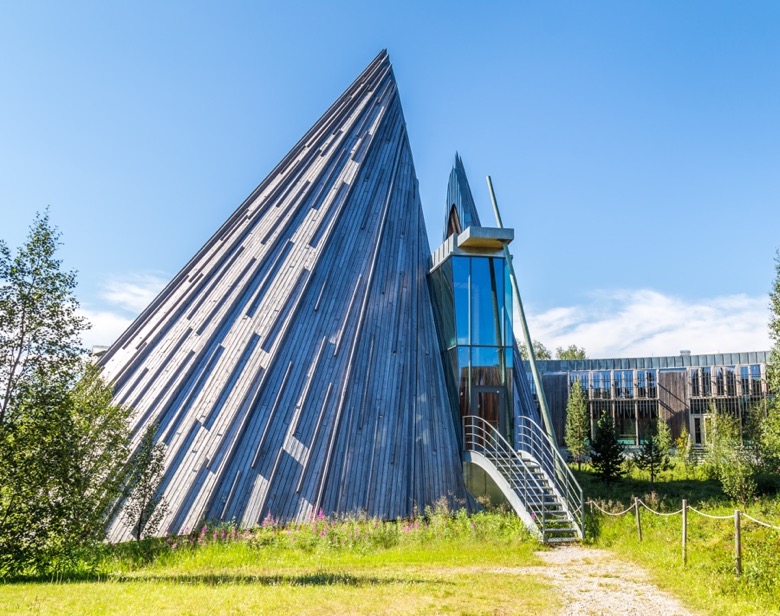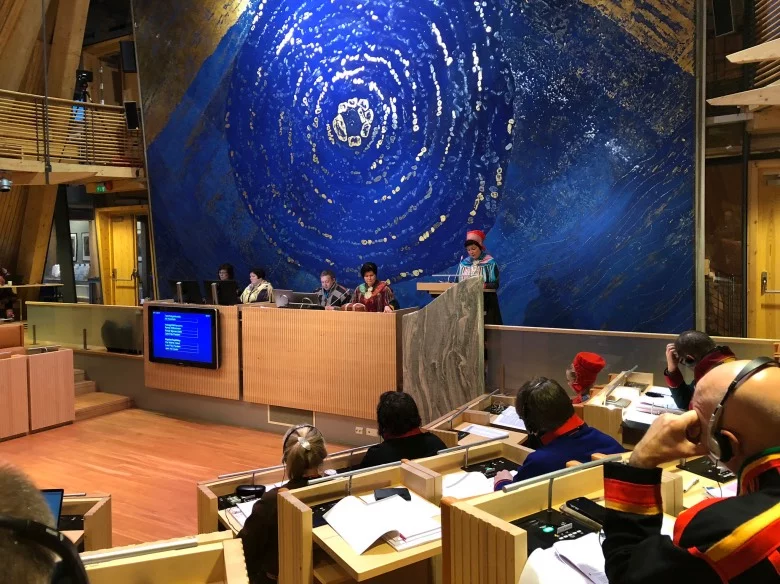Based in an impressive building in Karasjok, the Sami Parliament of Norway is the elected representative body for the Sami people in Norway.
Since 1989, the Sami Parliament has served as a cornerstone for indigenous self-determination, giving the Sami a formal voice in matters affecting their culture, language, and way of life.

Although it does not function as a legislative body in the same way as the Storting (Norwegian Parliament), the Sami Parliament holds significant influence. It helps shape national policy on indigenous issues, distributes funding, and works to preserve the rich heritage of Norway's indigenous population.
Who Are the Sami?
The Sami are the indigenous people of the Nordic region, traditionally inhabiting the vast northern areas known as Sápmi, which stretch across northern Norway, Sweden, Finland, and Russia's Kola Peninsula.
In Norway, the Sami population is concentrated in the north, particularly in Finnmark and parts of Troms and Nordland.
Historically, the Sami have lived off reindeer herding, fishing, hunting, and later, crafts and tourism. Despite centuries of marginalisation and forced assimilation under government policies, Sami identity, culture, and language have endured.
Today, they are recognised as an indigenous people under international law, with special protections in Norwegian legislation.
The Creation of the Sami Parliament
The Sami Parliament was established following decades of political pressure and activism, culminating in one of the most significant environmental and indigenous rights battles in modern Norwegian history: the Alta controversy.
In the late 1970s, the Norwegian Water Resources and Energy Directorate proposed the construction of a large hydroelectric dam on the Alta-Kautokeino river in Finnmark. The project aimed to generate renewable energy, but at great cost.

The proposed dam would have flooded the village of Máze (Masi), home to a longstanding Sami community, and would have disrupted vital reindeer migration routes.
In response, Sami activists, environmentalists, and local residents launched a sustained protest campaign. Demonstrations included hunger strikes outside the Norwegian Parliament in Oslo, legal appeals, and a blockade of the construction site in Alta in 1981.
At its height, hundreds of activists formed human chains to stop machinery, and police were deployed to forcibly remove protestors. It was an unprecedented event in modern Norwegian history.
The Alta case captured national and international attention, putting a spotlight on the marginalisation of Norway’s indigenous population. Although the dam was ultimately built, the protest movement succeeded in permanently shifting public discourse.
For the first time, indigenous rights became a mainstream political issue in Norway. In the wake of the protests, the Norwegian government initiated a series of reforms. The Sami Rights Committee was formed in 1980 to explore ways to strengthen Sami legal and political status.
Its recommendations led to the Sami Act of 1987, which established the legal foundation for the Sami Parliament. The Parliament officially opened in 1989.
What the Sami Parliament Does
The Sami Parliament is based in Karasjok, with additional offices in Kautokeino, Nesseby, Kåfjord (Troms), Tysfjord, and Snåsa. Its responsibilities include:
- Managing the Sami Development Fund and distributing cultural, educational, and economic grants.
- Promoting and protecting Sami languages, including Northern, Lule, and Southern Sami.
- Advising the Norwegian government on legislation, especially regarding land, resources, and cultural rights.
- Electing members to external bodies, such as three of the six seats on the board of the Finnmark Estate (FeFo), which manages nearly 96% of land in Finnmark.
- Supporting Sami media and education.
The Norwegian Ministry of Labour and Social Inclusion coordinates state-Sami relations. While the Ministry allocates national budget lines, the Sami Parliament determines how these funds are spent.
The Sami Parliament Building
The striking Parliament building in Karasjok is an architectural landmark, opened in 2000. Designed by architects Stein Halvorsen and Christian Sundby, the building is meant to evoke traditional Sami forms, most notably the lavvu (a Sami tent-like dwelling).

Its main hall features curved wooden beams and an abundance of natural light, symbolising transparency and cultural continuity. Sami language signage and indigenous artwork make the space both a working government building and a cultural statement.
Guided tours are offered once daily year-round on weekdays, and more frequently during the peak summer season (mid-June to mid-August).
Tours are conducted in Sami, Norwegian, and English. Visitors can learn about the building, the political process, and Sami culture more broadly.
How Sami Parliament Elections Work
Elections are held every four years and coincide with Norway’s national parliamentary elections. Only those registered on the Sami Parliament’s electoral roll may vote or run for office.
To register, an individual must:
- Self-identify as Sami.
- Have Sami as their home language or have a parent, grandparent, or great-grandparent who did.
- Be the child of someone already listed on the electoral roll.
Today, around 15,000 people are registered to vote in Sami parliamentary elections. Voters elect 39 representatives from seven constituencies across the country.
Leadership and Political Parties
The President of the Sami Parliament is the head of its executive branch and is chosen by the elected representatives after each parliamentary election.
Following the 2021 election, Silje Karine Muotka of the Norwegian Sami Association (NSR) assumed the presidency on October 21, 2021, succeeding Aili Keskitalo.
Muotka, who hails from Unjárga (Nesseby) and resides in Alta, has long been active in Sami politics—serving on the executive council since 2013—and holds degrees in law, culture, and business administration.
Muotka leads a coalition government known as the Beaiveálgu coalition, which brings together the NSR, the Centre Party, and the Ávjovári Moving Sami List.
This diverse alliance controls a majority of seats and governs through a council comprising the President and four full-time councillors responsible for areas such as reindeer husbandry, education, culture, and land rights.
The Sami Parliament features a mix of both Sami-specific parties—like NSR, Nordkalottfolket, Sámi People’s Party, and Ávjovári—and branches of national Norwegian parties, including the Labour and Centre parties, as well as the Progress Party.
In the 2021 election, NSR captured around 32 percent of the vote and 17 seats, while Nordkalottfolket rose to 9 seats with 18 percent. This blend of party types allows the Sami Parliament to maintain stronger ties to Norway’s national political landscape.

This inclusive model contrasts significantly with the Sami Parliament in Sweden, where only Sami-specific parties are allowed to contest seats, reinforcing Norway’s comparatively broader political inclusiveness.
International Standing and Comparison
Norway's Sami Parliament is considered one of the most influential indigenous representative bodies in Europe.
According to researchers and international observers, Norway provides a stronger platform for indigenous input than neighbouring Sweden and Finland, where Sami parliaments have fewer powers and less state engagement.
The three Nordic Sami parliaments do cooperate through the Sami Parliamentary Council, which addresses cross-border issues like language preservation, reindeer herding rights, and environmental protection.
Current Issues and Challenges
While the existence of the Sami Parliament is a major achievement, challenges remain. Despite the progress symbolized by the Sami Parliament, its power is still limited when it comes to resolving critical issues like land and resource rights.
In recent years, tension has grown between the Sami's traditional land-use needs—especially for reindeer herding—and proposals for wind farms and mining in northern Norway.
These clashes intensified in 2023 when a proposed wind-power project near Kautokeino sparked large protests from reindeer herders, who argued that even small-scale developments could fragment grazing areas and disrupt migration patterns crucial to their way of life.
The government initiated an independent review, but many Sami leaders argue that their consent should have been a precondition, not an afterthought—a reminder that the Parliament still lacks a binding veto over decisions on traditional lands.
Language preservation remains another critical concern. While the Parliament has successfully expanded educational programs in Northern Sami, the smaller Lule and Southern Sami languages continue to face extinction-level endangerment.
Despite funding initiatives, some classrooms still lack qualified teachers, and revitalization efforts can struggle to reach remote communities. The result: intergenerational language transmission remains fragile.
Engaging Sami youth in politics is also proving a challenge. Voter turnout among younger Sami in the 2021 election was noticeably lower than among older age groups. The Parliament has launched mentorship and digital outreach programs to bridge this gap, but long-term impact has yet to be seen.
Finally, critics contend that while the Sami Parliament is a platform for visibility and advocacy, it lacks legislative power. Its influence is largely advisory, reliant on state ministries to act on its recommendations.
Visiting the Sami Parliament
The Parliament building is located in Karasjok, a small town in Finnmark known for its Sami population and cultural institutions.
While the nearest airport is in Lakselv, most travellers will find it more practical to fly into Alta, which offers more frequent connections and better onward transport options. From Alta, Karasjok is around a two-hour drive or slightly longer bus journey.
Visitors are welcome on weekdays, with guided tours providing insight into the building's architecture, symbolism, and the role of the Parliament. An adjacent exhibition area often features Sami art and photography, helping to place the institution within the broader context of Sami cultural heritage.
For more information, visit the official website: sametinget.no (Norwegian/Sami only).


Very informative.l wish also to see with my vife Sami region Norway, Sweden, and Finland.l agree that your political system is very open minded.l reel myself closer Because of their languages similarities both of them originally from Ural-Altay languages.l hope to see after pandemi as soon as.Greetings from Türkiye.
Very informative.l wish also to see with my vife Sami region Norway, Sweden, and Finland.l agree that your political system is very open minded.l reel myself closer Because of their languages similarities both of them originally from Ural-Altay languages.l hope to see after pandemi as soon as.Greetings from Türkiye.